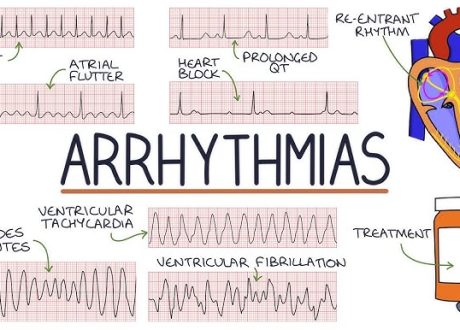Case Presentation
Apatient in their 60s was hospitalized with upper right quadrant discomfort for more than 10 days. The patient had a history of gastric cancer. Ultrasonography at a local hospital revealed multiple low-density foci in the liver. The patient had a history of coronary heart disease and had undergone a percutaneous coronary intervention at another hospital 1 year prior; the details were unknown. Laboratory examination showed a carcinoembryonic antigen level of 8.34 ng/mL (to convert to μg/L, multiply by 1.0) and an α-fetoprotein level of 9.97 ng/mL (to convert to μg/L, multiply by 1.0). Myocardial enzyme examination showed no abnormalities. During the course of the disease, the patient had no symptoms, such as chest tightness, chest pain, or syncope. After admission, two 12-lead electrocardiogram (ECG) examinations were performed (Figure). The Figure, A shows complete right bundle-branch block (CRBBB) with left anterior fascicular block (LAFB), though the second ECG (Figure, B) suggests CRBBB with left posterior fascicular block (LPFB).
A, Complete right bundle-branch block with left anterior fascicular block is shown. B, Complete right bundle-branch block with left posterior fascicular block is suggested; however, the left arm and left leg leads have been reversed by operator error. The key clues to the left arm/left leg reversal included the reversed polarity of the P wave in lead III and stable PR interval, distinguishing from alternating bundle-branch block.
Question: What causes such an apparent change in ECG findings?
Interpretation and Clinical Course
The first ECG (Figure, A) showed a sinus rhythm; a left axis deviation of −81°; an rS pattern in leads II, III, and aVF with SIII greater than SII; a blunt terminal S wave in the limb leads; and an rsR′ pattern in lead V1, suggesting CRBBB and LAFB. The second ECG (Figure, B) showed a right axis deviation of 135°; an rS pattern in leads I and aVL; a qRs pattern in leads II, III, and aVF; and an rsR′ pattern in lead V1, suggesting CRBBB and LPFB. These ECG changes indicated that the patient may have had alternating bundle-branch block. However, by carefully comparing the 2 ECGs, we found that they had an opposite P wave in lead III and a stable PR interval. Neither of these clues supported the diagnosis of alternating bundle-branch block. We decided to obtain another ECG immediately, and it was the same as the one in the Figure, A.
We found that the operator misplaced the left arm (LA) and left leg (LL) lead during the second ECG examination, resulting in an ECG waveform that was substantially different from that shown in the Figure, A. In both ECGs, the main changes were in the limb leads, and the chest leads were not affected. This result essentially suggested a change from LAFB to LPFB, independent of CRBBB.
Physicians consider diagnoses on the basis of comprehensive patient conditions, such as liver space-occupying lesions, gastric malignant neoplasm (postoperative), and coronary heart disease. In the case that LA/LL lead reversal caused the changes in ECG findings, not a true alternating bundle-branch block, pacemaker installation should not be considered. The patient also did not have any symptoms of syncope and amaurosis in the follow-up.
Discussion
The reversal of the LA/LL leads is uncommon and difficult to identify without a comparison ECG, given that aVR will be unchanged and, like in the case of left arm and right arm reversal, not very unusual appearing.1 Abdollah et al2 analyzed the mechanism of the changes in the QRS complex caused by LA/LL lead reversal. These authors pointed out that the positive and negative polarities of the leads changed when the LA/LL leads were reversed. The main changes were that leads I and II were exchanged, leads aVL and aVF were exchanged, and the positive and negative poles of lead III were reversed. In the present case, the key clues that could identify LA/LL lead reversal were the reversed polarity of the P wave in lead III and the stable PR (distinguishing from alternating bundle-branch block), which were found by comparison. Therefore, the diagnosis is hard to make without a comparison ECG. Lead reversals of any combination merit a repeat ECG, because they can mimic or mask major findings.
If a normal ECG has an LA/LL lead reversal, this reversed ECG is still in the normal category, and the resulting diagnosis or treatment will not be affected. However, in the case presented here, the patient had CRBBB and LAFB before, and the ECG showed CRBBB and LPFB when the LA/LL leads were reversed. Such intermittent ECG changes can easily be misdiagnosed as alternating bifascicular block if the physicians do not recognize lead reversal errors. According to the 2021 European Society of Cardiology guidelines on cardiac pacing and cardiac resynchronization therapy, pacemaker device implantation is recommended in patients with alternating bundle-branch block regardless of syncope.3 Because the rare phenomenon is often related to clinically significant infranodal disease, this can lead to patients developing atrioventricular block. In this case report, the cause of CRBBB with LAFB converting to CRBBB with LPFB was explained by LA/LL lead reversal, not alternating bundle-branch block. These findings indicated that LA/LL lead reversal can create the illusion of alternating bundle-branch block, and this meant that pacing therapy was not necessary. Physicians must be careful to rule out LA/LL lead reversal before making a diagnosis of alternating bundle-branch block.
Therefore, for patients with CRBBB and LAFB, LA/LL lead reversal can seriously affect the subsequent diagnosis and treatment direction. It is very important for clinicians to realize that LA/LL lead reversal may have occurred if a sudden transition from CRBBB with LAFB to CRBBB with LPFB occurs in a patient.
Take-home Points
-
The reversal of the LA/LL leads can create the illusion of alternating bundle-branch block. Without true alternating bundle-branch block, pacemaker implantation is unnecessary. If an ECG suddenly shows CRBBB and LPFB in a patient with inherent CRBBB and LAFB, physicians should rule out the possibility of LA/LL lead reversal before making a diagnosis of alternating bifascicular block.
-
Lead reversals of any combination merit a repeat ECG because they can mimic or mask major findings.












